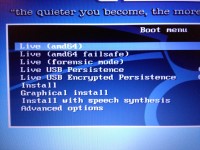Knoppix is basically for use with CD / DVD (above 7.2 only with DVD), but it can be installed on a pendrive - the system image itself is in the form of a file, and a second file is created that contains changes to the filesystem, so it effectively has filesystem R / W, but with the option of rolling back all changes.
The Knoppix image on a CD / DVD needs to be modified with the isohybrid program before saving to a USB flash drive (a regular CD / DVD image starts with 32kB zeros, you have to type something there so that it can boot from the USB flash drive, isohybrid just types it) . But the Knoppix DVD 8.1.0 image already has it.
Note: this image is not to be saved as a file on a pendrive, but as an entire pendrive (you can then create an additional partition on it so that it can also be used as a pendrive, not only for booting Knoppix); you can also start Knoppix from a CD / DVD and have it installed on a pendrive (then you have a normal partition and Knoppix files on it).
As you download Knoppix, beware of the language version (English and German), and the version for the blind (Adriana).
Ubuntu has the program wubi.exe, which does installation under Windows - no separate partition is needed, a file is created on the Windows partition, which is a disk image (probably there may be several files that will be images of several disks); when booting the computer you have the choice Windows / Ubuntu.
The virtual machine probably requires additional drivers for the system launched in it to see the network. Lilo probably is rarely used anymore, there is grub - lilo needs to be reinstalled every time you change something, grub needs to correct the configuration file (and usually the system does it automatically).



